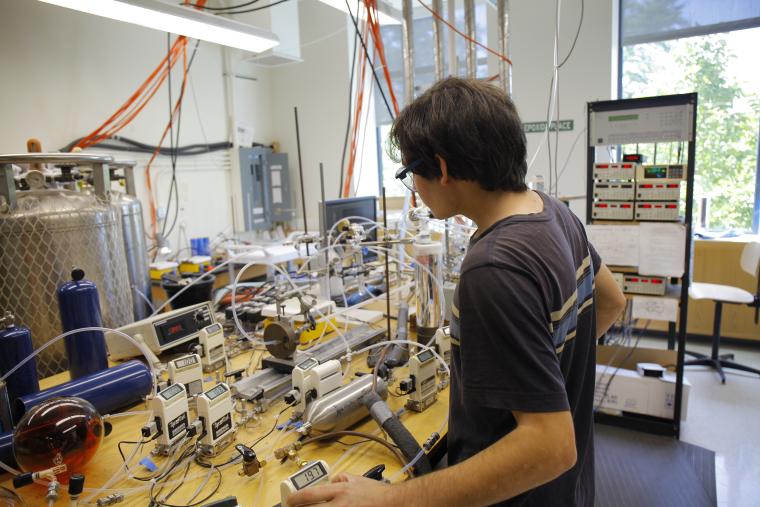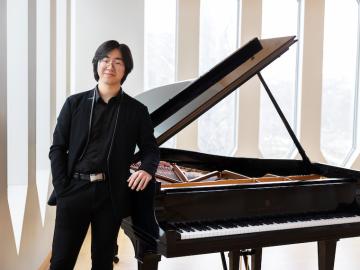Summer in Oberlin Means Research
August 20, 2013
James Helmsworth

Oberlin’s campus may appear tranquil in the summer, but inside its academic buildings students are hard at work. This summer, more than 90 students are on campus, working with faculty on scientific research. Though this occurs outside Oberlin’s normal academic calendar, it can be a critical part of a science education. Chemistry professor Matthew Elrod describes it as “the most intense kind of teaching” due to the amount of attention students receive from professors during this time. Over the summer, students also have more time to put professors’ guidance to use, as opposed with the research that occurs during the year.
This summer, not only are students learning how to work in a lab, but they’re also learning another important aspect of the field: how to report on their findings, with departments gathering every week for student presentations. In September, posters displaying the findings of all student and faculty summer research will on be display in the Science Center’s Perlik Commons.
The Air We Breathe
Backed by a $355,000 National Science Foundation (NSF) grant he received last year, Professor Elrod is researching the effects of chemical compounds produced by humans on compounds that occur naturally in the air.
Summer Research at Oberlin Each of Elrod’s students is testing a different set of chemical reactions. One of them, rising junior William Burke, is examining the chemicals created when NO2, which is produced by such things as car engines and power plants, reacts with the hydrocarbons in the atmosphere. Much of what he does is determine the quantities of the different compounds the reaction creates. “We can’t prevent all things, so we might as well prevent the worst things,” says Burke. “We’re finding out what is the worst thing.”
Eventually, Elrod’s research will result in atmospheric models that the Environmental Protection Agency will use to create policy and make predictions. When this happens, it will be thanks to, in part, the efforts of students like Burke.
“I focus everything I’ve got on their training and development scientists,” says Elrod.
The Water We Drink
Most people don’t get excited about the thought of drinking water purified with cow hair. Most people aren’t working in Associate Professor of Chemistry Jason Belitsky’s lab this summer.
In Belitsky’s lab, rising sophomores Edmund Korley, Sophie Lewandowski, and Eric Bell are researching the ability of melanin, the pigment that gives human skin and hair its color, to bind metals to itself. Their research could be developed to create both a melanin-based method of measuring water’s acidity, similar to pH strips, and a water purification system comprised solely of hair soaked in a strong base.
According to Korley, a chemistry and Africana studies major from Newark, New Jersey, their research could provide access to clean drinking water worldwide. “If you can get past the idea of drinking water washed with somebody else’s hair, it makes innovative technology, using melanin in cow hair, dog hair—waste hair, basically—to purify water,” he says. This technology is certainly necessary. According to a report by the World Health Organization and UNICEF, a 10th of the world uses unsafe water.
Professor Belitsky says that Korley, Lewandowski, and Bell have been valuable to his research. “They have contributed many good ideas to the project,” he says. “They have been great to work with and are quite productive. In fact, when I spent a week away from lab at a conference, they were twice as productive without me around!"
How Plants Eat
“When we are hungry, we go to the garden or the kitchen and get something to eat,” but plants, explains Marta Laskowski, associate professor of biology, cannot do this. “Instead, they adjust the number of lateral or branch roots that they form.”
Marta LaskowskiThe former type of root growth, lateral root formation, comprises much of Laskowski’s research. This summer, she’s joined in her lab by rising senior Ari Schwartz and May 2013 graduate Seth Greenbaum.
The pair is studying the roles different plant hormones,and root curvature play in dictating where lateral roots grow. They have spent much of the summer crossbreeding mutated plants that are missing certain hormones with plants engineered to turn blue where lateral roots will form.
According to Greenbaum and Schwartz, research like this could be used to refine the methods used to grow such vegetables as broccoli and kale, which are part of the same family as the mustard plants they are studying. “Understanding the way plants grow and the way plants take in nutrients helps people understand how they thrive in their soil,” says Schwartz. “Learning how lateral roots are developed means that you can change and develop how plants grow.”
Tags:
You may also like…
Students Create Project That Engages Local Hospital Patients and Nursing Home Residents
June 4, 2024
Oboist Meera Bhatia ’23 and flutist Emily Nixon ’23 visited local hospital and nursing homes over the past academic year, commissioning and premiering a piece by Jeff Scott through the Gletherow-Young-Deppman Project Award.
Violinist Maya Irizarry Lambright to Solo with Oberlin Orchestra
May 9, 2024
A winner of the 2023-24 Senior Concerto Competition, Lambright will open the program with Shulamit Ran's Violin Concerto. The second half of the program features the orchestra in Nikolai Rimsky-Korsakov's Scheherazade.
Pianist Jiongli Wang to Perform with Oberlin Chamber Orchestra
May 2, 2024
On Friday, May 3, the Oberlin Chamber Orchestra performs a program that will showcase Concerto Competition winner Jiongli Wang in Frédéric Chopin’s First Piano Concerto, as well as fourth-year composition student Cashel Day-Lewis in the premiere of his Black River Prelude commissioned by Oberlin Conservatory in honor of the Lorain County Bicentennial.


